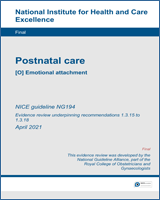|
Guedeney 2013
RCT
France
| N=440 women randomised to:
Intervention n=222 Control n=218
Median age for the whole population: 22 years | Intervention group:
Control group:
The intervention was tailored to each family’s needs and consisted of home visits during pregnancy and up to the child’s second birthday, with decreasing frequency of visits over time: 6 visits during the antenatal period, 8 in the first 3 months’ postpartum, 15 between the fourth and twelfth months’ postpartum, and another 15 during the child’s second year of life, resulting in a total of 44 home visits per family |
The Alarm Distress Baby Scale (ADBB) consisting of 8 items (assessed at 18 months of infant age):
- -
facial expression - -
eye contact - -
general level of activity - -
self-stimulation gestures - -
vocalizations - -
rapidity of response to stimulation - -
relationship with the observer - -
attractiveness to the observer
|
|
Hans 2013
RCT
US
| N=248 women randomised to:
Intervention n=124 Control n=124
Age, mean (SD):
Intervention 18 (1.7) Control 17.9 (1.7)
| Intervention group:
Control group:
Doulas scheduled weekly visits with each woman in the intervention groups throughout her pregnancy and until 3 months post-partum |
Mother-child interaction measured using the Parent–Child Observation Guide (PCOG) consisting of mother and child variables (assessed at 12 months of infant age):
- -
mother variables (mother sensitive responsiveness, encouragement and guidance, mother prompt responsiveness to upset (for children who displayed upset)) - -
child variables (positive involvement with mother, child displayed no uncomfortably long period of distress)
|
|
Kemp 2011
RCT
Australia
| N=208 women randomised to:
Intervention n=111 Control n=97
Age, mean (SD):
Intervention 27.6 (6.7) Control 27.7 (5.9)
| Intervention group:
Control group:
Women in the intervention group received an average of 16 (range 0–52) visits, each of 60–90 min duration, by a child health nurse commencing at on average 26 weeks gestation (range 12–40), and continuing to their child’s second birthday |
Mother-child interaction during free play measured using the National Institute for Child Health and Development scales of parent–child interaction consisting of 3 items (assessed at 18 months of baby age):
- -
sensitive stimulating parenting - -
detached flat parenting - -
child engagement
|
|
Walkup 2009
RCT
US
| N=167 women randomised to:
Intervention n=81 Control n=86
Median age for the whole population: 18 years. | Intervention group:
Paraprofessional-delivered, home-visiting intervention (the Family Spirit intervention based on recommendations and standards documented in the American Academy of Paediatrics’ Caring for Your Baby and Child: Birth to Age 5. This includes developmentally timed prenatal and infant-care parenting lessons, family planning, substance abuse prevention, and problem-solving and coping-skills lesson)
Control group:
Mothers received home-visiting lessons from 28 weeks’ gestation to 6 months postpartum |
Social emotional problems and competencies of child measured using the Infant Toddler Social Emotional Assessment (ITSEA) consisting of 4 domains (assessed at 12 months of baby age):
- -
externalising domain (includes activity/ impulsivity, aggression/ defiance, peer aggression - -
internalising domain (includes depression/ withdraw, general anxiety, separation distress, inhibition to novelty) - -
dysregulation domain (includes sleep, negative emotionality, eating, sensory sensitivity) - -
competence domain (includes compliance, attention, imitation/play, mastery motivation, empathy, prosocial peer relations)
|

